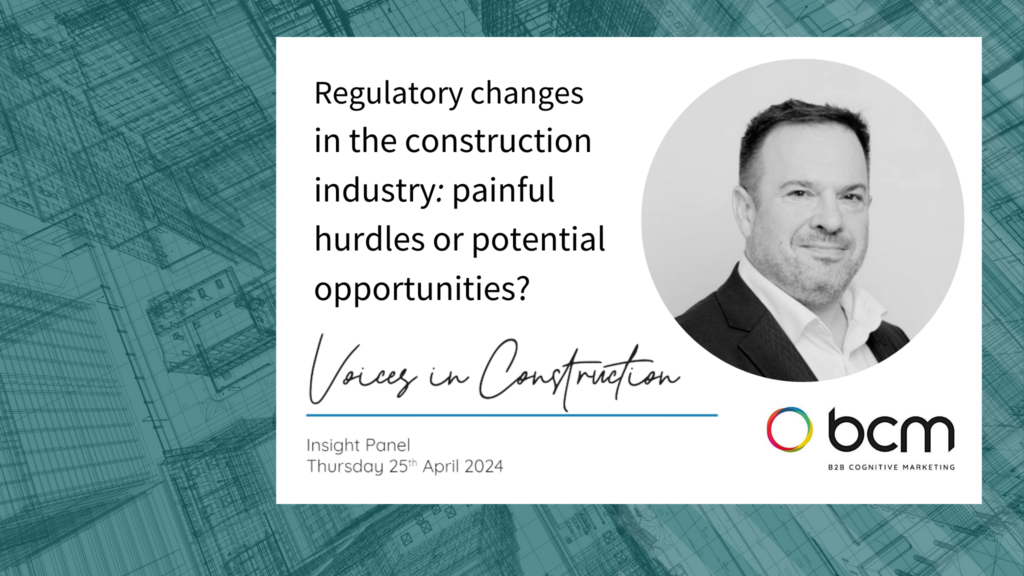London Belgravia Group’s Commercial Director, Alex Lyons, was invited to share his insights on recent and future changes to construction legislation as part of a Voices in Construction Insight Panel – hosted by BCM.
This multidisciplinary group, which brought together professionals from construction, insurance, and building control, included David Aitchison BCC Consultancy, John Carter GeoGrow, Simon Green Green Building Design, and Rachel Legood Hertfordshire Building Control.
BCM captured the key areas of discussion, offering valuable insights for those in the construction industry. We highly recommend reading the full report, which we’ve summarised below.
Regulatory change: setting the scene
The construction industry’s recent regulatory changes are significant and complex. Updates are dispersed across numerous acts and have been communicated piecemeal by the government, making it challenging for professionals to track and comprehend the changes cohesively. This fragmented dissemination complicates understanding, enacting, and complying with new regulations, posing significant challenges for all construction professionals.
Considering changes introduced by the Building Safety Act 2023 and the Building Regulations 2023, changes to the Building Act 1984, new Biodiversity Net Gain (BNG) requirements, and potential requirements of the Future Homes and Future Building Standard, the panel offered insight to help construction professionals from across the industry understand the challenges and opportunities created by these changes.
The panellists emphasised the risks of non-compliance and that developers relying on insurance for liabilities are opening themselves to significant risk. They emphasised the vital need for education and the value of multidisciplinary technical support to manage increased complexity, project delays, and additional costs due to new enforcement powers and Gateway submissions. Potential slowdowns within regulatory bodies are also noted, but the long-term benefits for end clients, including safer and better-constructed properties, are stressed.
Registration, competence, enforcement
Highlighting significant changes in building control, the panel recognised the emphasis of the new responsibilities of duty holders—principal designers and contractors—in ensuring compliance with building regulations throughout project phases.
- Registration – Rachel Legood discussed how the Building Safety Regulator (BSR) mandates the registration of building inspectors, ensuring they are certified and qualified for specific building types. The registration process clarifies inspectors’ qualifications, akin to a driving license specifying permissible vehicle types.
- Competence—David Aitchison elaborates on these changes, heralding what he terms “a new beginning for building control.” The BSR’s enhanced competency assessments aim to ensure that inspectors are adequately trained and capable of enforcing regulations. Continuous Professional Development (CPD) and training initiatives are essential to meeting the new competency standards.
- Enforcement – Building control bodies now have increased enforcement powers, shifting from advisory roles to authoritative enforcement without time constraints. New enforcement capabilities aim to rectify past compliance issues and promote more sustainable and safe construction practices.
Regulatory change: sustainability’s saviour?
The new building control amendments regarding sustainability are positive, Simon Green shared. They address past weaknesses that hindered energy-efficient building design. Restored building control authority will enable better enforcement and practical oversight, promoting sustainable construction practices.
The impact on doing business
The panel highlighted the value of seeking specialist, multidisciplinary technical support to manage the new compliance requirements. This is key to avoiding project delays and additional costs that are a risk following the regulatory updates, new enforcement powers and increased complexity of Gateway submissions. Education campaigns, including those on biodiversity net gain and heat pumps, are also crucial, John Carter explained, as they support the industry in adapting to regulatory changes.
What’s the effect on clients and end-clients?
Developers and other stakeholders can and will adapt to regulatory changes, but Alex Lyons underlined the risks of non-compliance. There are huge opportunities for proactive adopters, especially those who invest in education and expertise. He recommended that engaging early with a broker and having multi-disciplinary support in place can help ensure success. He highlighted two examples’ areas where getting expert support early is invaluable:
- Developers are at risk of passing Gateway 2 only to find that a particular material does not meet the insurance requirements. They would then have to upgrade materials or components and risk delays due to with the new requirement to submit significant changes back to BSR.
- The new enforcement powers, duty holder requirements and Gateway submissions have increased management complexity, and the risk of potential project delays, and additional costs.
Specialist brokers can offer developers advice to help streamline this process and meet both building regulations requirements and warranty provider’s technical standards
Learn more about navigating the new BSR Gateways 2 & 3 in our recent articles: What does it mean for developers and why engaging multi-disciplinary support is key
Hurdles or opportunities?
Regulatory changes in the construction sector are extensive and complex and often perceived as adding management overheads, costs, and bureaucracy, especially in a challenging environment with housing shortages, volatile material costs, and a skills shortage.
Despite these challenges, the panellists unanimously support the changes, recognising their necessity to improve safety, quality, and sustainability in the industry. The new regulations are seen not only as future improvements but also as corrections to past deficiencies, addressing issues that remain prominent in public consciousness.
The panel explored the evolving regulatory landscape in detail; read the full write-up here: Regulatory Changes in Construction – Hurdles or Opportunities? Evaluating the State of Play.

